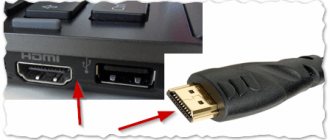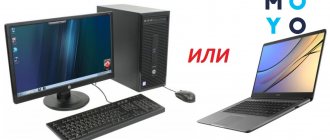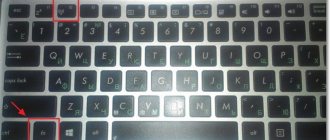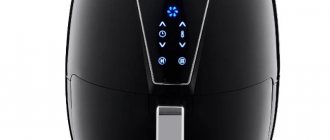Today we will connect an external monitor to a laptop, netbook, or ultrabook and configure the whole thing in Windows 10 and Windows 7. If you have Windows 8, everything will work out. I just don’t have this system installed on my laptop, so I won’t be able to show everything and take screenshots. In general, in the process of connecting a laptop to a monitor, it doesn’t make much difference what version of Windows you have installed. In most cases, it is enough to simply connect the monitor to the laptop via an HDMI cable, or VGA, DVI, USB Type-C. We will also talk about which connection interface is best to use and what cable (possibly an adapter) we need.
My laptop is almost always connected to the monitor. Plus a wireless keyboard and mouse. That is, I have a laptop as a system unit. It is very comfortable. I can turn off my laptop at any time and take it with me. It is almost silent compared to a PC. And thanks to the monitor I connect to at home, I can comfortably work on the big screen, watch movies, play games, etc.
In addition, the screen quality on laptops is very poor. I will introduce models from the budget and mid-price segments. Or old laptops.
Everyone has different tasks. And there can be a lot of cases when we may need to connect a monitor. Someone will connect to a large screen to watch movies, take their laptop to work and connect to a monitor there for more comfortable work, or, like me, use it as a desktop computer. In any case, we need to somehow connect and configure these two devices. By the way, you can use a TV instead of a monitor.
To begin with, we will find out what connection interface (output) is on our laptop, we will also check whether there is the same port (input) on the monitor and we will already decide which one to use. And of course we will need a certain cable. In some cases, an adapter may also be needed.
Which interface and cable should I use to connect my laptop to the monitor?
At this stage it is very difficult to give any specific and universal recommendations. For the reason that everyone has different laptops and monitors. Therefore, we will consider the most popular connection options. One of them should suit you.
The most optimal and common interface for connecting a monitor to a laptop is HDMI . It is available on almost every laptop and monitor. Even if your devices are not the newest. If you find an HDMI output on your laptop and an input on your monitor, then use that.
First, look at your laptop. I’ll show you everything using the example of two of my laptops. The new but budget Lenovo only has an HDMI output. As I already wrote, this is the optimal solution.
The second, older ASUS laptop has the same HDMI digital output and the now outdated VGA.
What other options might there be?
- Older laptops may only have a VGA output.
- It's rare, but sometimes laptops have a DVI output.
- On modern gaming laptops, in addition to HDMI, there may also be a mini Display Port.
- On new ultrabooks (mostly expensive models) there is no separate output for connecting an external monitor. There, a new USB Type-C port is used for these tasks. And since there are now very few monitors with a USB Type-C input, you will most likely need an adapter. For example, USB-C - HDMI.
We sorted out the laptop. Now look at your monitor. What connection interfaces are there? My monitor has two HDMI inputs and one VGA (D-Sub).
Since my laptop has an HDMI output, and my monitor has an HDMI input, of course I will use this interface to connect.
But, as you understand, this does not always happen. Let's consider these options:
- The monitor does not have an HDMI input. And there are, for example, only DVI and VGA. In this case, you can connect via VGA (if there is such an output on the laptop). But, if your laptop has HDMI, then it is best to use an HDMI to DVI adapter.
- The laptop only has HDMI, but the monitor has VGA. You can also use an adapter. There are enough of them on the market. But, since VGA is not a digital output, the picture quality may not be very good.
Simply put, when both devices do not have the same interfaces, then you need to look towards adapters. And it’s better not to use outdated VGA for connection. If there is such a possibility.
I think we've sorted out the connection interface. Depending on the selected interface, we will need a cable or adapter. I have a regular HDMI cable.
Very common. You can buy it at almost any digital store. Comes in different lengths. Just say that you need a cable to connect your computer to your monitor. I've been using the same cable for several years now.
How to connect a laptop to a TV or monitor via cable?
Once the video connectors on the laptop and on the external device in the form of a monitor or TV have been found, all that remains is to simply connect them with the appropriate cable.
It doesn’t matter which cable you use to connect the monitor to the laptop. If your laptop and monitor have a VGA connector, then connect the VGA cable that looks like this:
VGA cable for connecting a laptop to a monitor or TV
Moreover, most likely your monitor to which you are going to connect the laptop was previously connected with a VGA cable to the computer system unit.
If VGA is not on the monitor or laptop, then most likely there should be HDMI or DVI connectors.
This is what HDMI and DVI cables look like:
HDMI cable for connecting a laptop to a monitor or TV
DVI cable for connecting a laptop to a monitor or TV
Features of connecting to a TV
As for connecting to a TV, it is recommended to use an HDMI cable, since it transmits not only the image from the laptop, but also the sound. This way the TV will have image and sound from the laptop.
When you connect the laptop to the monitor with the selected cable, the image on the monitor will appear automatically. Only sometimes it may be necessary to select a signal source in the monitor menu. (VGA, HDMI, DVI).
As for the TV, there is a high probability that you will have to use the “Source” or “Input” button on the remote control to select the signal source.
After connecting the laptop and the TV with a cable, if the image does not appear automatically, try switching the sources on the TV in order.
Connect the monitor to the laptop via HDMI cable
It is recommended to disconnect both devices before connecting the cable. Honestly, I don’t turn it off. Nothing's burned yet











